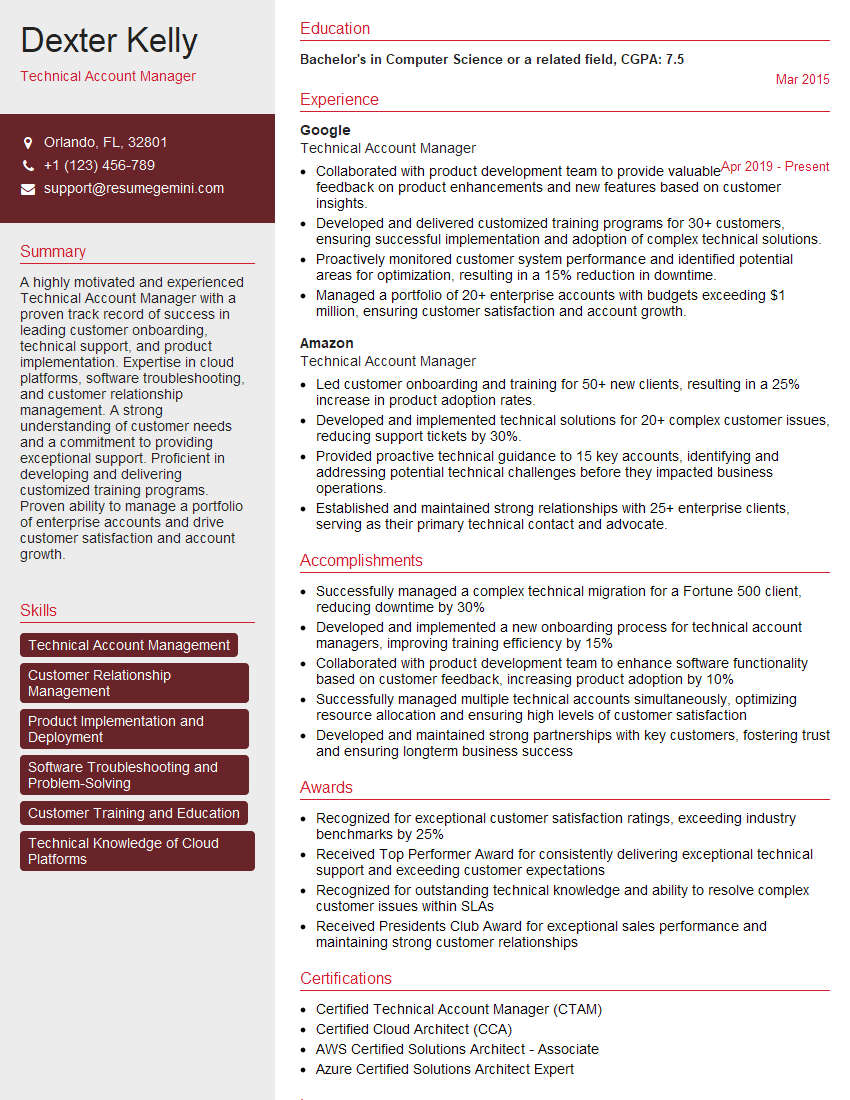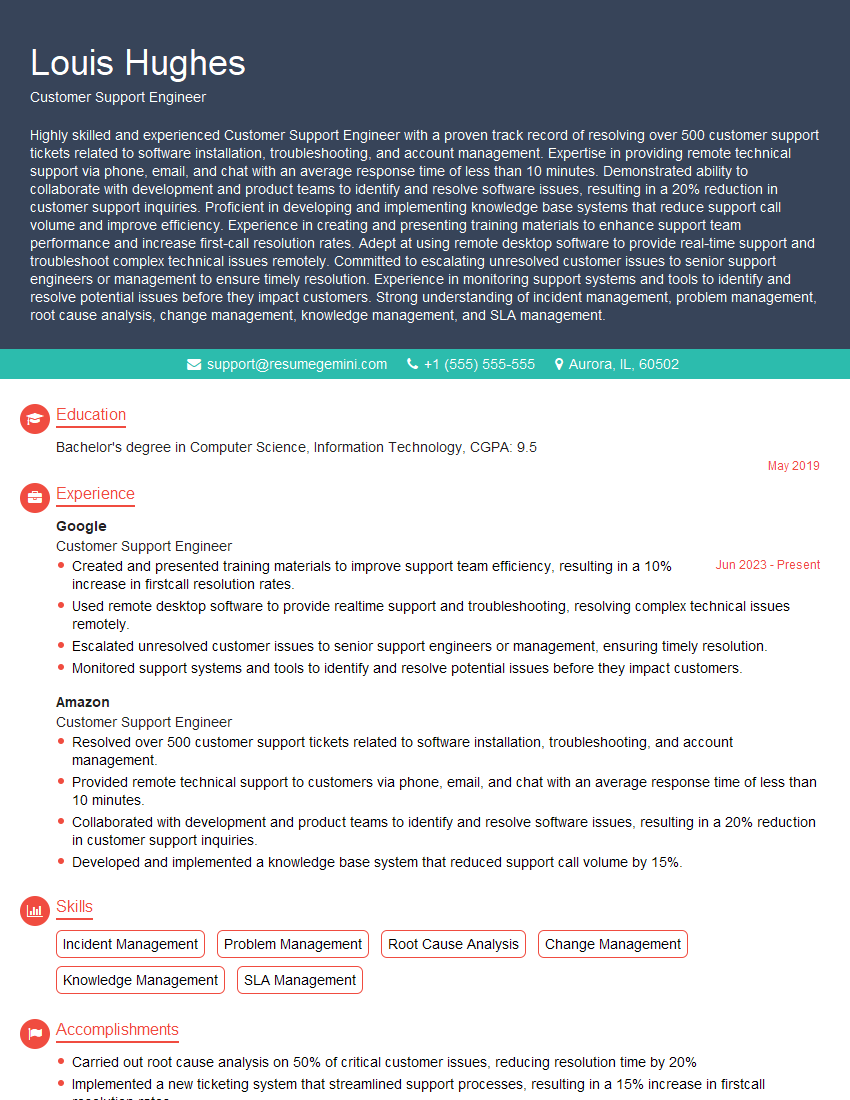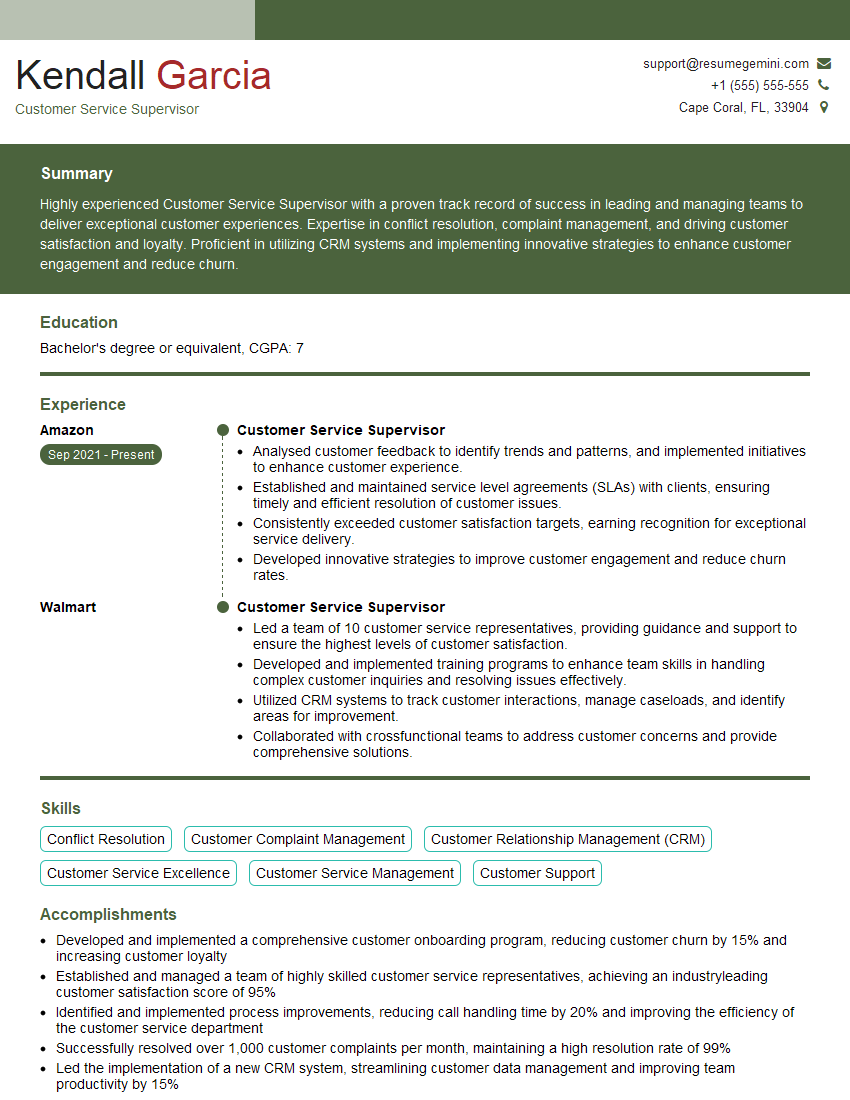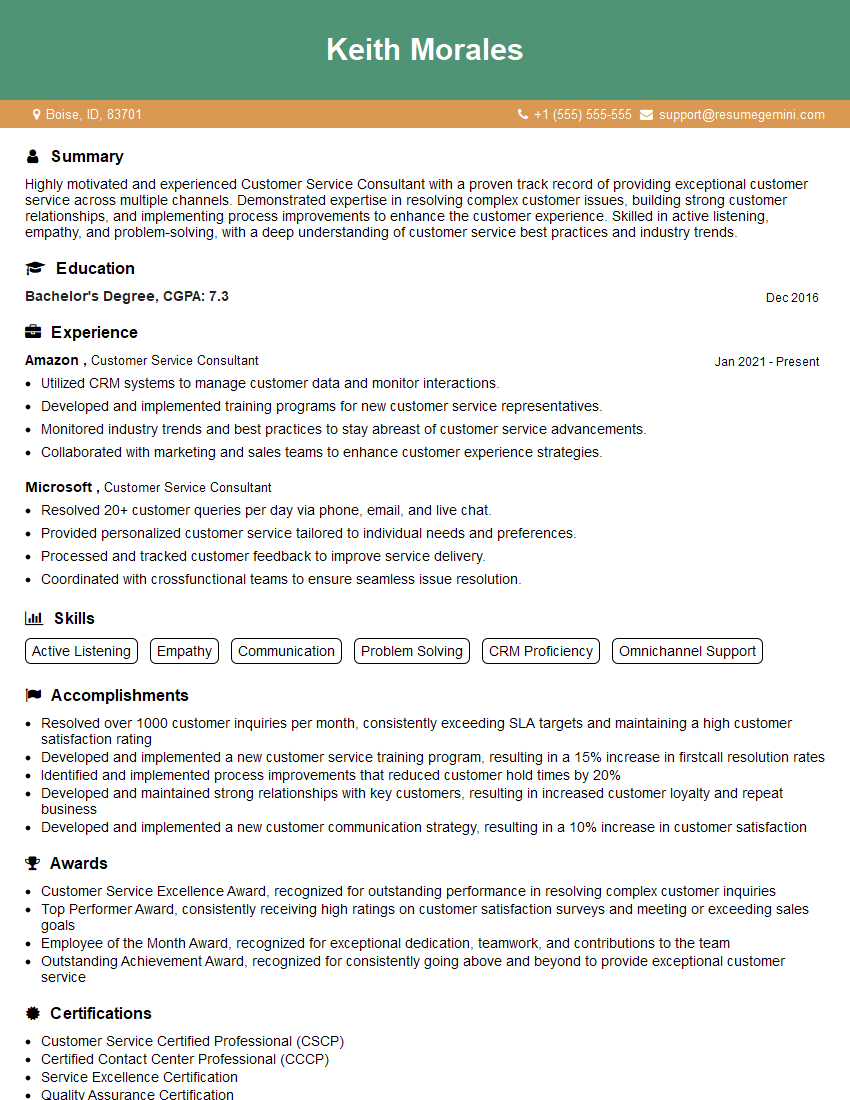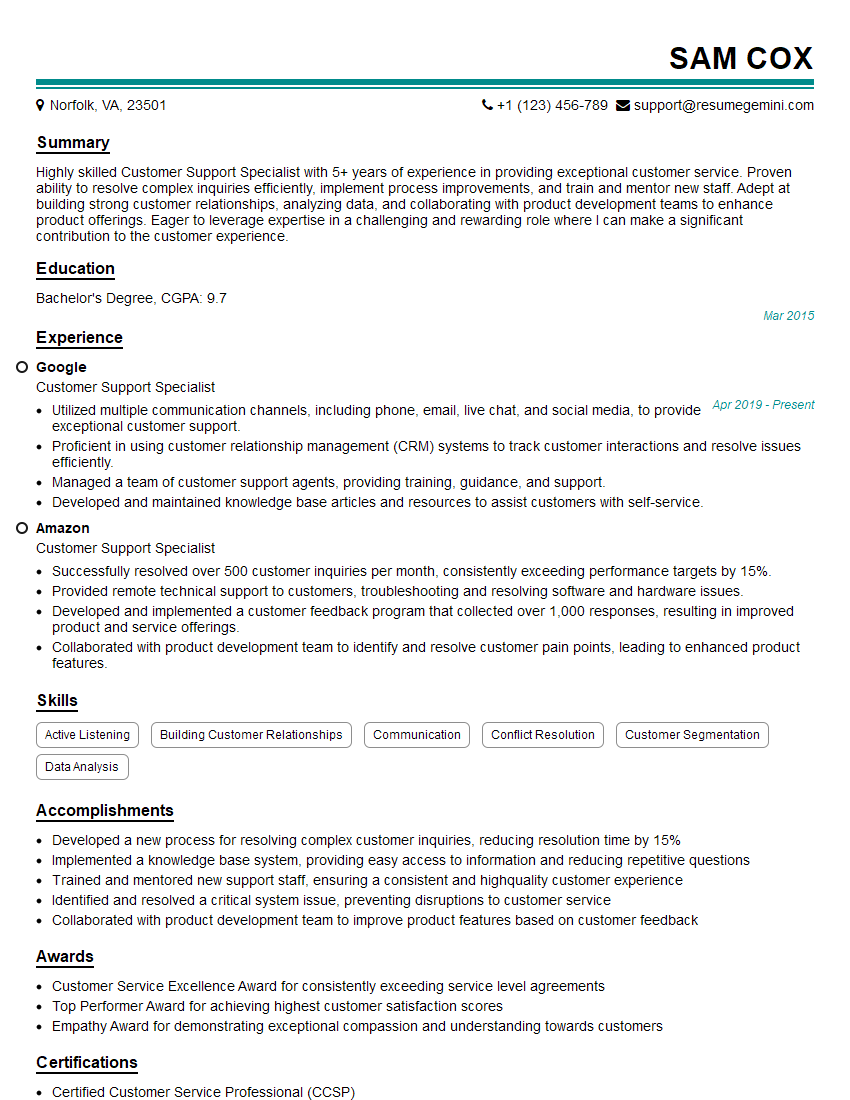Interviews are opportunities to demonstrate your expertise, and this guide is here to help you shine. Explore the essential Resolve Customer Queries interview questions that employers frequently ask, paired with strategies for crafting responses that set you apart from the competition.
Questions Asked in Resolve Customer Queries Interview
Q 1. Describe your process for prioritizing customer queries.
Prioritizing customer queries is crucial for efficient support. My process involves a multi-faceted approach, combining urgency and impact. I use a system that considers several factors:
- Urgency: Queries requiring immediate attention, such as outages or critical security issues, take precedence. These are often flagged with high priority in our ticketing system.
- Impact: The potential impact of unresolved issues on the customer’s business or experience is another key factor. A widespread system failure affecting many users will be prioritized higher than an individual account query.
- Service Level Agreements (SLAs): We adhere to predefined SLAs, which specify response and resolution times for different query types. Queries violating SLAs automatically get elevated priority.
- Customer Segmentation: High-value customers or those with critical contracts often receive expedited support.
Essentially, it’s a blend of automated prioritization based on system rules and my own judgment based on the context of each query. Think of it like a triage system in a hospital – the most critical cases are addressed first.
Q 2. How do you handle a customer escalation?
Handling customer escalations requires a calm, empathetic approach. My first step is to actively listen to the customer’s concerns, acknowledging their frustration. I then summarize their issue to ensure mutual understanding. Next, I investigate the root cause thoroughly, involving other team members or departments if necessary. Transparency is key – I keep the customer updated on my progress and any delays. Finally, I present a resolution plan and follow up to ensure the issue is fully resolved and the customer is satisfied. For example, if a customer escalates a billing issue after multiple unsuccessful attempts to resolve it via email, I would personally review the billing details, apologize for the inconvenience, and offer a solution like a credit or adjusted billing statement. I aim to turn a negative experience into a positive one by demonstrating commitment to resolving the issue and exceeding their expectations.
Q 3. What is your approach to resolving a complex customer issue?
Resolving complex customer issues requires a structured approach. I begin by gathering all relevant information, including detailed descriptions of the problem, error messages, logs, and any previous attempts at resolution. Then I break down the problem into smaller, more manageable components. This approach allows for a systematic investigation, reducing the chance of overlooking crucial details. Next, I research potential solutions, leveraging internal documentation, knowledge bases, and external resources. If the issue is beyond my expertise, I consult with senior colleagues or specialists within the company. Throughout the process, I maintain clear communication with the customer, keeping them informed of my progress and any roadblocks encountered. Finally, once a solution is implemented, I conduct thorough testing to ensure the issue is fully resolved and there are no unintended side effects. For instance, a complex issue might involve troubleshooting a software integration problem requiring collaboration with the development team and understanding the intricate dependencies between different software modules.
Q 4. Explain your experience with ticketing systems.
I have extensive experience with various ticketing systems, including Zendesk, Jira Service Desk, and Freshdesk. I’m proficient in using these systems to manage customer inquiries, track progress, escalate issues, and generate reports. I understand the importance of accurate ticket categorization and tagging for efficient routing and reporting. I’m comfortable using advanced features like automation rules, macros, and custom fields to streamline workflows and improve team productivity. My experience includes configuring and customizing these systems to meet specific business needs, improving efficiency and customer satisfaction through optimized processes. For example, I once implemented a custom field in our ticketing system to track the specific product version affected by a customer’s issue, improving the speed and accuracy of our troubleshooting process.
Q 5. How do you manage your time when dealing with multiple customer queries?
Managing multiple customer queries efficiently requires a structured approach. I utilize time management techniques such as prioritizing tasks based on urgency and impact (as described earlier), batching similar tasks together to reduce context switching, and setting realistic time blocks for each query. I also leverage the features of the ticketing system to manage my workload, such as setting reminders and utilizing the prioritization features to ensure urgent queries are addressed immediately. Furthermore, effective communication is key; I update customers promptly on the status of their queries to manage expectations and avoid unnecessary follow-ups. I use tools like calendars and to-do lists to stay organized and avoid feeling overwhelmed.
Q 6. Describe a situation where you had to deal with an angry customer.
I once had a customer who was extremely angry about a billing error that resulted in an overcharge. The customer was verbally abusive and made several unreasonable demands. My approach was to remain calm, listen empathetically, and validate their feelings. I didn’t interrupt or argue, letting them vent their frustration. Once they had finished, I apologized sincerely for the error and explained the steps I would take to correct it. I then provided them with a detailed explanation of the billing issue, demonstrating transparency and showing that I understood their concerns. I assured them that I would personally handle the correction and would follow up within 24 hours. I offered a goodwill gesture, such as a credit to their account. By the end of the interaction, the customer was much calmer and appreciative of my professional and understanding response. This experience reinforced the importance of empathy and calm, consistent communication when dealing with angry customers.
Q 7. How do you ensure customer satisfaction?
Ensuring customer satisfaction is paramount. My approach centers around proactive communication, efficient problem-solving, and exceeding expectations. Proactive communication includes regular updates to keep the customer informed, even if there’s no immediate resolution. Efficient problem-solving involves a structured approach (as described earlier), ensuring a timely and effective resolution. Exceeding expectations means going the extra mile – offering additional assistance, proactively identifying and addressing potential future issues, and leaving the customer feeling valued and heard. I always aim to leave every customer interaction feeling positive, even if the initial issue was difficult. For example, if a customer has a minor issue, I don’t just solve the problem; I also offer relevant tips or resources to prevent similar issues in the future. By combining these methods, I create a positive customer experience.
Q 8. How familiar are you with different customer service metrics (e.g., CSAT, NPS)?
Customer service metrics are crucial for measuring the effectiveness of support efforts. They provide quantifiable data to understand customer satisfaction and identify areas for improvement. I’m very familiar with several key metrics, including:
- CSAT (Customer Satisfaction Score): This measures how satisfied customers are with their experience. It’s typically measured through post-interaction surveys asking customers to rate their satisfaction on a scale (e.g., 1-5 or 1-7).
- NPS (Net Promoter Score): This metric gauges customer loyalty and willingness to recommend a product or service. It’s based on a single question: “On a scale of 0-10, how likely are you to recommend [company/product] to a friend or colleague?” Responses are categorized as Promoters (9-10), Passives (7-8), and Detractors (0-6). The NPS is calculated by subtracting the percentage of Detractors from the percentage of Promoters.
- First Contact Resolution (FCR): This measures the percentage of customer issues resolved on the first contact. High FCR indicates efficient and effective support.
- Average Handle Time (AHT): This metric measures the average time spent resolving a customer issue. While a low AHT is desirable, it shouldn’t come at the cost of resolution quality.
- Customer Effort Score (CES): This measures how much effort a customer had to expend to resolve their issue. A low CES indicates a positive experience, even if the resolution wasn’t immediate.
In my previous role, we used CSAT and NPS regularly to track performance, identify trends, and adjust our strategies. For example, consistently low CSAT scores for a particular product feature pointed to a usability issue that we addressed through improvements to the design and user interface.
Q 9. What is your experience with using CRM software?
I have extensive experience using CRM (Customer Relationship Management) software, primarily Salesforce and Zendesk. I’m proficient in managing customer accounts, tracking interactions, and utilizing reporting functionalities. In my previous role, I used Salesforce to:
- Manage customer profiles: Updating contact information, interaction history, and notes.
- Track support tickets: Assigning tickets, monitoring their progress, and ensuring timely resolution.
- Generate reports and dashboards: Analyzing key metrics such as CSAT, NPS, and AHT to identify areas of improvement.
- Integrate with other tools: Connecting the CRM with our helpdesk and knowledge base for seamless workflow.
I understand the importance of data accuracy and consistency in a CRM system, and I am adept at maintaining up-to-date information to ensure effective customer support.
Q 10. How do you identify the root cause of a recurring customer problem?
Identifying the root cause of a recurring customer problem requires a systematic approach. I typically follow these steps:
- Gather data: Collect all relevant information about the recurring problem, including customer reports, error logs, and system data.
- Analyze patterns: Look for commonalities among affected customers, systems, or timeframes. Are specific browsers, operating systems, or usage patterns implicated?
- Test hypotheses: Based on the patterns identified, develop and test hypotheses to determine the root cause. This may involve reproducing the issue in a controlled environment.
- Collaborate: If necessary, consult with other teams (e.g., engineering, product development) to obtain additional expertise and insight.
- Document findings: Thoroughly document the root cause, the steps taken to identify it, and any implemented solutions. This ensures the problem doesn’t resurface.
For example, recurring login issues might initially seem isolated. However, by analyzing log data, I might find a pattern tied to a specific version of a browser, leading to an update recommendation or bug fix for the developers.
Q 11. How do you handle situations where you cannot immediately resolve a customer’s issue?
When I can’t immediately resolve a customer’s issue, I prioritize transparency and proactive communication. My approach involves:
- Acknowledging the issue: Empathize with the customer and let them know I understand their frustration.
- Setting clear expectations: Provide an estimated timeframe for resolution and explain the steps I will take.
- Keeping the customer informed: Provide regular updates on progress, even if there are no significant developments.
- Escalating if necessary: If I’m unable to resolve the issue, I will escalate it to the appropriate team (e.g., engineering, management) while keeping the customer informed.
- Following up: Once the issue is resolved, I follow up with the customer to ensure their satisfaction and address any remaining concerns.
I treat every unresolved issue as an opportunity to improve my skills and the company’s support processes. This might involve creating a knowledge base article to prevent similar issues in the future.
Q 12. How do you document customer interactions and resolutions?
Documentation is crucial for efficient customer support. I meticulously document all customer interactions and resolutions using the CRM system. This includes:
- Detailed notes on the issue: A clear description of the problem, steps taken to reproduce it, and any relevant error messages.
- Steps taken to resolve the issue: A record of actions performed, resources consulted, and any changes made.
- Resolution outcome: Confirmation that the issue was resolved, along with any follow-up actions.
- Customer feedback: Notes on the customer’s satisfaction level and any additional feedback.
Well-documented interactions allow other support agents to quickly understand the customer’s history and efficiently handle future inquiries, improving efficiency and consistency across the team.
Q 13. What is your experience using knowledge base articles to resolve customer issues?
Knowledge base articles are invaluable resources for resolving customer issues quickly and efficiently. I am experienced in using knowledge base articles to:
- Identify solutions: I use keywords related to the customer’s issue to search the knowledge base for relevant articles.
- Provide solutions: If I find a relevant article, I use the information to resolve the customer’s issue and direct them to the knowledge base for self-service options.
- Supplement my knowledge: I use the knowledge base to refresh my understanding of company products, services, and policies.
- Identify patterns and trends: Frequent access to the same article might highlight a recurring issue that needs further investigation.
In my experience, a well-maintained knowledge base significantly reduces resolution times and enhances customer satisfaction. It empowers customers to troubleshoot problems independently, freeing up support agents to focus on more complex issues.
Q 14. How do you communicate technical information to non-technical customers?
Communicating technical information to non-technical customers requires clear, concise, and relatable language. I avoid technical jargon and instead use analogies and simple explanations. My approach involves:
- Using plain language: Avoid industry-specific terms and technical acronyms.
- Employing analogies: Relate technical concepts to everyday experiences the customer can understand.
- Visual aids: If appropriate, use diagrams, screenshots, or videos to illustrate complex ideas.
- Breaking down complex information: Present information in small, digestible chunks rather than overwhelming the customer with a large amount of detail at once.
- Active listening: Confirm understanding by asking clarifying questions and summarizing key points.
For example, instead of saying “The database experienced a transient failure,” I might say, “There was a temporary glitch with our system’s internal files, but it’s been fixed now.”
Q 15. Describe your experience with remote troubleshooting.
Remote troubleshooting requires a structured approach and strong communication skills. My experience involves utilizing a range of remote access tools like TeamViewer and AnyDesk to diagnose and resolve technical issues for clients. I begin by establishing a clear understanding of the problem, asking probing questions to gather information. This includes confirming the client’s operating system, software versions, and network configuration. Then, I guide them through troubleshooting steps, often using screen-sharing to visualize the issue and provide real-time assistance. For instance, I recently helped a client remotely resolve a printer connectivity issue by walking them through a network configuration check and driver update. Throughout the process, I document all steps taken and solutions implemented, ensuring a clear record for future reference. Crucially, I maintain clear and patient communication, explaining technical concepts in plain language to avoid overwhelming the client.
Career Expert Tips:
- Ace those interviews! Prepare effectively by reviewing the Top 50 Most Common Interview Questions on ResumeGemini.
- Navigate your job search with confidence! Explore a wide range of Career Tips on ResumeGemini. Learn about common challenges and recommendations to overcome them.
- Craft the perfect resume! Master the Art of Resume Writing with ResumeGemini’s guide. Showcase your unique qualifications and achievements effectively.
- Don’t miss out on holiday savings! Build your dream resume with ResumeGemini’s ATS optimized templates.
Q 16. How do you stay up-to-date with product knowledge?
Staying current with product knowledge is paramount in this role. I employ a multi-faceted approach. Firstly, I regularly consult official product documentation, release notes, and knowledge bases provided by the manufacturers. Secondly, I actively participate in online forums and communities dedicated to the specific products I support, engaging with other professionals and learning from their experiences. Thirdly, I take advantage of any available training resources, including webinars and online courses offered by vendors or internal training programs. Finally, I also use a personal system of note-taking and knowledge management to organize the information I learn and make it readily accessible when needed. This ensures I’m prepared to address any questions or issues efficiently and effectively.
Q 17. Describe a time you had to adapt your communication style to suit a particular customer.
I once encountered a frustrated customer who was struggling with a complex technical issue. Their initial communication was quite aggressive and demanding. I recognized the need to adapt my communication style from a purely technical one to a more empathetic and patient approach. I began by acknowledging their frustration and validating their feelings. I actively listened to their concerns without interrupting, ensuring I understood the situation fully before jumping into technical solutions. I used simpler language and avoided technical jargon, explaining complex concepts using analogies they could easily grasp. By demonstrating empathy and patience, I built rapport, leading to a successful resolution and a positive customer experience. The key was shifting from a purely problem-solving mindset to a customer-centric approach prioritizing understanding and emotional connection.
Q 18. How do you handle multiple simultaneous customer queries effectively?
Handling multiple simultaneous queries requires organization and prioritization skills. I typically use a ticketing system to manage incoming requests. This system allows me to categorize, assign priority levels (e.g., urgent, high, medium, low), and track progress on each query. I prioritize based on urgency and impact, addressing critical issues first. I also utilize time-management techniques like the Pomodoro Technique to focus my attention and prevent burnout. Furthermore, I proactively communicate with customers regarding estimated wait times, setting realistic expectations. This approach ensures fairness and prevents customer frustration due to perceived neglect. This keeps both the customers and myself informed and helps prevent issues from escalating.
Q 19. How familiar are you with different communication channels (e.g., phone, email, chat)?
I’m proficient across various communication channels, including phone, email, and chat. Each channel offers unique advantages. Phone calls provide immediate interaction and allow for a more personal and nuanced understanding of the customer’s needs. Email facilitates detailed information exchange and allows for a structured record of the interaction. Chat is ideal for quick questions and real-time assistance. My approach is to choose the most appropriate channel based on the nature of the query and the customer’s preference. For example, I’d use a phone call for complex technical issues requiring real-time guidance and email for non-urgent requests requiring detailed explanations or documentation. I adapt my communication style to suit each channel, maintaining a professional and courteous tone.
Q 20. Describe a time you had to go above and beyond for a customer.
I recall a situation where a customer was facing a critical system failure just before a major deadline. Their usual support channels were unresponsive. I went above and beyond by staying late into the evening to work through the issue with them. I successfully identified and resolved the problem, preventing significant data loss and meeting their deadline. While it wasn’t part of my standard duties, ensuring the customer’s success was paramount. This experience highlighted the value of proactive problem-solving and going the extra mile to build strong customer relationships. It reaffirmed my commitment to providing exceptional customer service even outside of my normal working hours when it truly matters.
Q 21. What is your approach to conflict resolution with customers?
My approach to conflict resolution is built on empathy, active listening, and clear communication. I begin by acknowledging the customer’s frustration and validating their concerns. I actively listen to their perspective without interrupting, seeking to understand the root cause of their dissatisfaction. Then, I explain the situation from my perspective, clearly and calmly. I work collaboratively with the customer to identify a mutually agreeable solution, focusing on finding a resolution that addresses their needs while upholding company policies. If a complete resolution is not immediately possible, I maintain open communication and provide regular updates, keeping the customer informed throughout the process. My goal is always to de-escalate the situation and turn a negative experience into a positive one, reinforcing their trust in the company.
Q 22. How do you utilize feedback to improve customer service processes?
Customer feedback is the lifeblood of improving customer service. I utilize feedback through a multi-step process. First, I ensure we have various channels for collecting feedback, including surveys, post-interaction emails, and direct feedback forms. Then, I meticulously analyze this data, looking for trends and patterns. For example, if many customers mention difficulty navigating our website’s FAQ section, that signals a need for improvement. This analysis leads to actionable steps. We might redesign the FAQ section, create video tutorials, or add more intuitive search functionality. Finally, I track the impact of these changes by monitoring customer satisfaction scores and feedback volume. This cyclical process ensures continuous improvement.
For example, in my previous role, customer feedback revealed frustration with long hold times. By implementing a callback system and optimizing our staffing schedules based on peak demand, we significantly reduced wait times and improved customer satisfaction.
Q 23. Describe your experience with using self-service portals for resolving customer issues.
I have extensive experience using self-service portals, viewing them as crucial for efficient customer service. These portals empower customers to resolve issues independently, freeing up agents to handle more complex problems. I’m proficient in using various portal features, including knowledge bases, FAQs, troubleshooting guides, and online chatbots. I’ve found that a well-designed self-service portal needs to be intuitive, easily searchable, and provide accurate, up-to-date information. I also believe in integrating a seamless escalation path within the portal; if a customer can’t find a solution, they should easily be able to connect with a live agent.
In one instance, I helped improve a company’s self-service portal by adding interactive troubleshooting tools. This led to a 20% reduction in calls to the customer service center.
Q 24. How do you ensure data security and privacy when handling customer queries?
Data security and privacy are paramount. I adhere strictly to company policies and relevant regulations like GDPR and CCPA when handling customer queries. This involves using secure systems for data storage and transmission, employing strong passwords and access controls, and regularly updating security software. I never share customer information unnecessarily and always obtain explicit consent before collecting or using sensitive data. Furthermore, I am trained on data breach protocols and know how to report any potential security incidents immediately.
For example, if a customer emails with a sensitive issue, I would never reply from my personal email address and would always use the company’s secure communication channels.
Q 25. Explain your process for escalating customer complaints to the relevant team.
My escalation process is clear and efficient. When a customer complaint can’t be resolved at my level, I first attempt to thoroughly document the issue, including all relevant details and previous attempts at resolution. Then, I escalate the complaint to the appropriate team, providing this comprehensive documentation. This ensures a smooth transition and avoids repetition of information. I will also inform the customer of the escalation and provide an estimated timeframe for a response. Throughout the process, I maintain transparent communication with both the customer and the relevant team to ensure a prompt and satisfactory resolution.
For instance, if a technical issue requires the involvement of the engineering team, I provide them with all the relevant logs, screenshots and customer communication so that they can efficiently diagnose and resolve the issue.
Q 26. How familiar are you with compliance regulations regarding customer data?
I have a strong understanding of compliance regulations regarding customer data, including GDPR, CCPA, and HIPAA (where applicable). I know the importance of obtaining consent, data minimization, data security, and the customer’s right to access, rectification, and erasure of their data. I understand the potential penalties for non-compliance and always strive to maintain the highest standards of data protection. I regularly participate in training sessions to stay updated on changes and best practices in data privacy.
Q 27. What are some common customer service challenges you’ve faced and how did you overcome them?
Common challenges include dealing with irate customers, managing high call volumes during peak times, and resolving complex issues that require collaboration with multiple teams. To overcome these, I use active listening and empathy to de-escalate angry customers, prioritize tasks based on urgency and impact, and proactively seek support from colleagues when needed. Utilizing effective communication strategies and building rapport are key. I view every challenge as an opportunity to improve my skills and the overall customer experience.
One time, I faced a particularly challenging situation where a customer’s order was lost. By remaining calm, understanding the customer’s frustration, and working diligently with the logistics team, we managed to trace the order and ultimately deliver a replacement within 24 hours. This reinforced the importance of both patience and efficient problem-solving in resolving difficult situations.
Q 28. How would you prioritize customer requests with varying levels of urgency?
Prioritizing customer requests involves a multi-faceted approach. I utilize a system that considers urgency and impact. I use a matrix where I categorize requests based on urgency (high, medium, low) and impact (high, medium, low). High urgency, high impact requests (e.g., a critical system outage affecting many customers) are prioritized immediately. Medium urgency, high impact (e.g., a major account experiencing difficulties) are handled next. I then address high urgency, medium impact requests (e.g., individual customer experiencing critical issues) before addressing other requests. This structured approach ensures that the most critical issues are addressed swiftly and effectively.
This system allows me to ensure that requests are addressed according to their level of significance. I make sure to communicate clearly to the customer regarding where their request falls within the queue.
Key Topics to Learn for Resolve Customer Queries Interview
- Understanding Customer Needs: Active listening techniques, empathy, and identifying the root cause of customer issues, not just surface-level complaints.
- Communication Strategies: Effective verbal and written communication, adapting your style to different customer personalities and communication preferences (email, phone, chat). Practicing clear, concise, and professional language is key.
- Problem-Solving Methodologies: Structured approaches to troubleshooting, using a systematic process to identify solutions. This includes escalating issues appropriately when necessary.
- Technical Proficiency (if applicable): Depending on the role, familiarity with relevant software, databases, or internal systems used to access customer information and resolve their queries. Be prepared to discuss your experience with these tools.
- De-escalation Techniques: Handling difficult or angry customers, maintaining composure, and using calming language to resolve conflicts effectively. Role-playing these scenarios can be very beneficial.
- Compliance and Policies: Understanding and adhering to company policies, data privacy regulations, and security protocols when handling customer information. Demonstrate your awareness of ethical considerations.
- Performance Metrics: Familiarity with key performance indicators (KPIs) related to customer service, such as resolution time, customer satisfaction scores, and first-contact resolution rates. Be prepared to discuss how you would contribute to improving these metrics.
Next Steps
Mastering the art of resolving customer queries is crucial for career advancement in any customer-facing role. It demonstrates essential skills like communication, problem-solving, and empathy, all highly valued by employers. To significantly boost your job prospects, create an ATS-friendly resume that highlights these skills effectively. ResumeGemini is a trusted resource that can help you build a professional and impactful resume. We provide examples of resumes tailored to “Resolve Customer Queries” roles to guide you. Take the next step and craft a resume that showcases your capabilities to land your dream job!
Explore more articles
Users Rating of Our Blogs
Share Your Experience
We value your feedback! Please rate our content and share your thoughts (optional).
What Readers Say About Our Blog
Hi, I’m Jay, we have a few potential clients that are interested in your services, thought you might be a good fit. I’d love to talk about the details, when do you have time to talk?
Best,
Jay
Founder | CEO





